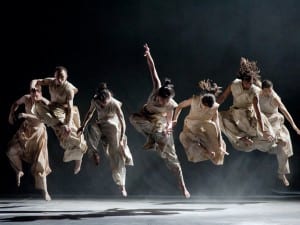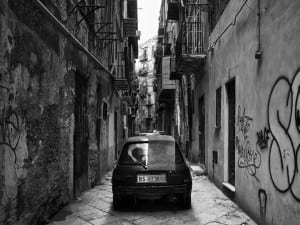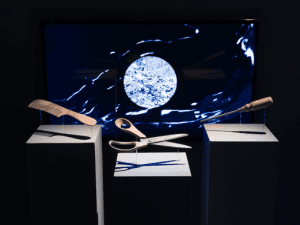Text by Regina Papachlimitzou
Museum Show Part II, the second part of the Arnolfini’s ultimate 50th anniversary exhibition, continues exploring the preoccupations touched upon by Museum Show Part I with a distinct shift of focus onto more anthropological and socio-historical concerns.
Occupying the first floor gallery, works such as Jaime Davidovich’s Museum of Television Culture and Maarten Vanden Eynde’s Museum of Forgotten History examine the specific interconnections (or lack thereof) between the contents of a museum-institution and the ‘real’ world. Museum of Television Culture sets off from Theodor Adorno’s observation that “the German word museal […] describes objects to which the observer no longer has a vital relationship and which are in the process of dying. […] Museum and mausoleum are connected by more than phonetic association. Museums are like the family sepulchres of works of art.” The idea of a museum as the place where art goes to die informs the piece, in the uncomfortable parallel drawn between museums and television: in the same way art can be viewed as already dead, or somehow spent, once it is being displayed in a museum, human life as displayed on TV can be said to have lost an essential component of itself –to have, in some way, died. Davidovich’s work is an almost sinister reminder of this idea, consisting as it does of a shelving unit populated by myriads of TV sets of all shapes and sizes, silent and unmoving, juxtaposed with an actual TV set on which a looped clip is monotonously postulating and analysing the relationship between museum and mausoleum.
Museum of Forgotten History almost follows on from this idea, by offering up a collection of works representing ‘remnants of a possible future past’. The breakdown and dissipation of meaning so strongly suggested in Davidovich’s work also recurs in Maarten Vanden Eynde’s. Works such as Modern Menhir (a curious, menhir-shaped, redbrick structure, as secretive and exclusive as it is challenging and open to interpretation), or Ikea-Vase (an amphora-shaped vase made of reconstruction paste and incorporating the fragments of an Ikea mug) question the ability of historical artefacts to truly impress on us what life in an inherently unknowable past would have been like –and in the process point out out the fallacious impressions a future archaeologist might conceivably formulate on our present based on its surviving remnants.
On the first floor, we encounter Karen Mizra and Brad Butler’s Museum of Non-Participation: a collection of ‘acts’, dubbed by the artists as ‘the performative utterance of folded, contested spaces’. Act 0015 is displayed across three monitors that only turn on as soon as a visitor walks past, the three of them providing a sort of chorus of speech acts to the Museum of Non-Participation as a whole. The first monitor features speech acts by actor and activist Khalid Abdalla (the particular clip explores the representation of Arab population in American media, with snatches of the actor/activist’s phrases echoed by a wistful, dreamlike female voice); the second monitor features a series of photographs interspersed by explanatory notes, neither of which stay on-screen long enough to allow for proper contemplation or even taking in (the photographs and notes deal with events surrounding and stemming from military intervention in the Middle East); the third monitor features a prolonged clip of artist Nabil Ahmed discussing issues relating to the language movement in Bangladesh (the speaker switches between languages, the sound is occasionally muted; at times the black censorship strip appears over the speaker’s mouth or eyes, other times the entire image blurs). All three elements of the work act separately and unison to demonstrate the simultaneous power and powerlessness of speech acts, and to underline the close interdependence between it and the visual in the creation of collective memory.
Tucked into the smallest exhibition space, on the third floor of the Arnolfini, Khalil Rabah’s Palestinian Museum of Natural History and Humankind makes perhaps the most poignant statement among the Museum-works showcased. A fictional institution with an authoritative voice, an almost unbearable blurring of the line between fictitiousness and reality, Rabah’s work acts as both a reminder and a parody of the tenuous connection between the purpose and contents of a museum as an institution and the reality of the world outside it. At the same time, the spectator’s painful awareness (or lack thereof) of the fact that Palestine does not, in fact, have a national museum infuses the work, paradoxically reinforcing the significance of museum institutions in the creation and preservation of a national heritage, culture, and identity. The work showcased in the Arnolfini is the archive section of the Palestinian Museum: it consists of large wood-framed canvasses neatly stacked side-by-side, each full of information near impossible to read due to their proximity to each other. Nonetheless, the information is there, in addition to which there is a promising presence of three empty wooden frames waiting to be filled. The fictional archive of a national museum of a nation without a recognised state, Palestinian Museum speaks to the human need for memory, and the struggle of this memory to keep itself alive against the forces of the present.
Museum Show Part II is an intriguing exploration of the extent to which the world and our experience of it are, essentially, a construct and one in which memory plays a key part; and it is precisely this dimension of our world that the works showcased are interested in exposing.
Museum Show Part II, 09/12/2011 – 19/02/2012, Arnolfini, 16 Narrow Quay, Bristol, BS1 4QA. www.arnolfini.org.uk
Aesthetica in Print
If you only read Aesthetica online, you’re missing out. The December/January issue of Aesthetica offers a diverse range of features from The Way We Live Now, which is on at the Design Museum, London, to Anselm Kiefer opening at Tel Aviv Museum of Art, to a look at Danser Sa Vie at Pompidou Centre, which examines the place dance holds in art history. Plus it comes with its very own DVD of short films from the Aesthetica Short Film Festival.
If you would like to buy this issue, you can search for your nearest stockist here. Better yet call +44 (0) 1904 629 137 or visit the website to subscribe to Aesthetica for a year and save 20% on the printed magazine.
Captions:
1. Museum of Non-Participation
Karen Mirza & Brad Butler
Installation shot, Arnolfini 2011
2. Museum of Incest
Simon Fujiware
Installation shot, Arnolfini 2011
3. Palestinian Museum of Natural History and Humankind
Khalil Rabah
Installation shot, Arnolfini 2011
4. Museum of Forgotten History
Maarten Vanden Eynde
Installation shot, Arnolfini 2011
Photography: © Jamie Woodley




